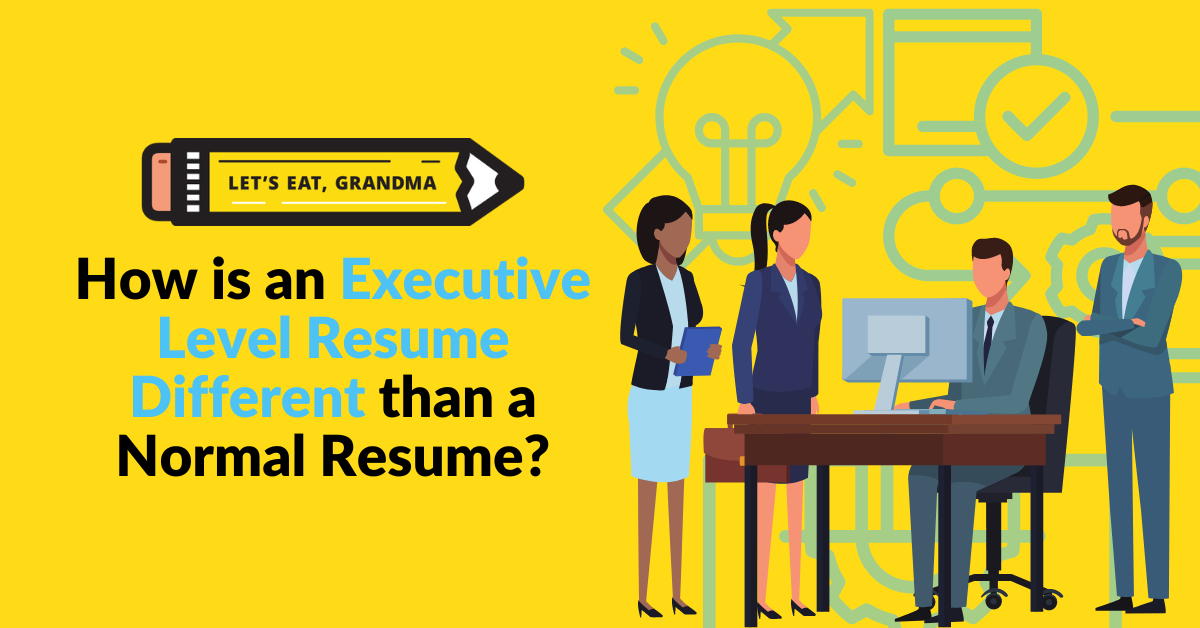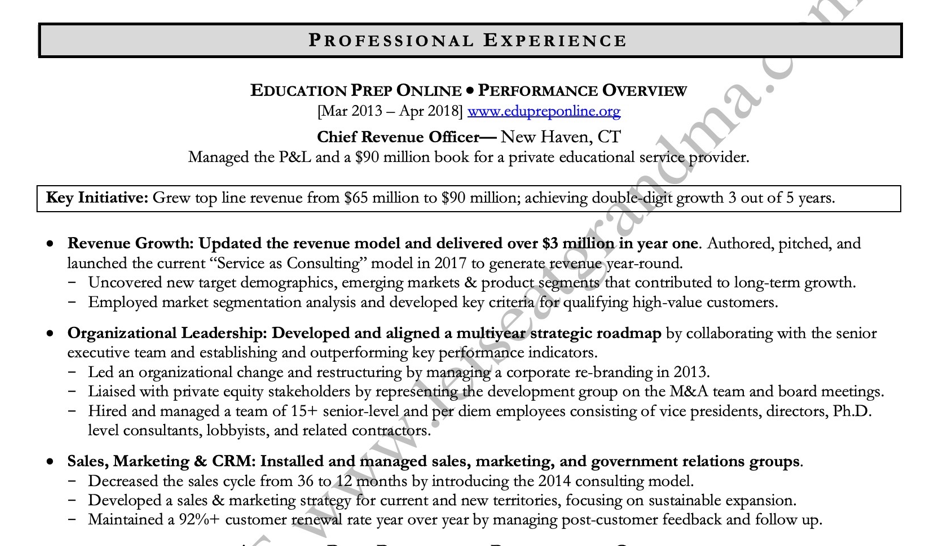How Is an Executive-Level Resume Different Than a Normal One?

With a long career and many notable accomplishments, you may need an executive-level resume. They can help you beat out the competition by highlighting your leadership skills, technical strengths, and business acumen.
Editor’s note: This post was originally published in 2022; it has been updated for accuracy and comprehensiveness.
By: Ashley Dolar | Contributor for Let’s Eat, Grandma
Imagine that you see an opening for a coveted senior-level position in your company. You have all of the qualifications, and you even know the hiring manager. It was just posted today. Plenty of time to put together an executive-level resume.
But you have that big presentation to give tomorrow. And those talking points to develop. Plus, your anniversary is coming up and you still need to figure out a gift…or dinner…or something to impress your equally busy partner.
Then it hits you. This isn’t just a normal resume. This is an executive-level resume. The stakes are higher than ever before.
For starters, your executive profile needs to tell the story of your career and your unique value-add without wasting valuable space on platitudes and cliches. (Let’s all agree that overused business jargon is on its way out the door. Synergy, anyone?)
Next, your key achievements need to be conveyed through tight, crisp bullet points with meaningful metrics. Finally, the focus needs to be on the most recent, essential, and marketable information.
Ready for more job search help?
Sign up for a free Senior Writer Resume Critique to see what's holding you back from landing interviews. One of our top professional resume writers will give you personalized feedback on the top 3 items you can improve based on our expert practices!

Photo by bruce mars on Unsplash
What are the sections of an executive-level resume?
Typically, an executive-level resume contains the same elements as a standard resume. However, the level of language and the way you organize information are key differences to think through before submitting your resume to a high-level position. You can think of it as creating an easy-to-read marketing document–with the focus being on your professional successes and personal brand.
So, what are the main sections of an executive-level resume?
Contact Info
Start with your name and contact info, including your LinkedIn profile. If you don’t have a LinkedIn profile, we suggest creating one to help with networking and leadership appeal.
You should also have an updated email address from a modern, trustworthy domain. We usually recommend Gmail from Google and Outlook from Microsoft. They both offer free email addresses, and they are easy to navigate. Mostly, you don’t want to use an outdated email domain like AOL, Hotmail, or Juno because then you may begin dealing with an ageism situation.
Headline
Consider framing your executive-level resume with an eye-catching headline. While it’s not a mandatory piece of the resume puzzle, it is a powerful way to create interest in your application. (In fact, it’s been known to convince recruiters to continue reading and persuade hiring managers to pick up the phone!)
Executive Profile/Executive Summary
Banish the traditional objective statement in favor of an engaging summary of qualifications section. It can help a potential employer quickly understand your professional strengths and leadership philosophy–and see if your skillset is aligned with their company goals.
In the best-case scenario, it also creates an immediate connection with your target audience, making it more likely that your executive-level resume stays at the top of the pile. This is especially important if you’re changing industries or have a gap in experience because it puts to rest any red flags or assumptions about your career path.

Areas of Expertise
Summarize both your soft skills and in-demand technical skills. This section shouldn’t take up too much space on your resume, so putting your skills in categorized subsections is a good rule of thumb.
Professional Experience
List your most recent and relevant positions along with accomplishment-based bullet points. For each position include your job title, company, and dates of employment.

The best bullet points begin with an action verb, briefly explain your contribution, and state your results. It’s a simple, eye-catching formula that paints a clear picture of your past outcomes and future success.
If you need help getting started with this all-important section, here are a few examples of executive-level resume bullet points from different industries:
Sales
- Redesigned global sales strategy with renewed focus on consultative selling, exceeding growth targets by 25% within six months
Operations
- Led the construction phrase of an $85M pipeline project with a 15-person team, driving subcontracting efficiencies and negotiating a 95% reduction on a $16M contractor claim
Marketing
- Built a tiered-loyalty program with a global team within one year, increasing monthly website traffic by 20% and doubling average spend per customer
Technology
- Oversaw a $50M cybersecurity project involving multiple departments and a 25-person team, resulting in a fully updated SaaS contract management system
Nonprofit
- Secured a $230K state grant to develop an inter-district, science-themed summer program, serving 2K children and their families annually
Education
Be sure to include any degrees, concentrations, and universities here. If you have more than one major or undergraduate degree, list them separately. You probably don’t need to list the year of graduation, unless you earned the degree within the past five years.
You may also have sections for any relevant licenses, certifications, training courses, volunteer work, professional affiliations, awards, and honors.
You’ll need to take some time to determine how to present any additional roles from early in your career. A job title from 20+ years ago might deserve a mention in an Additional Experience section, or you may be better served to list it in the Experience section of your LinkedIn profile. It just depends on your unique situation.

Photo by Javier Sierra on Unsplash
How long should an executive-level resume be?
It’s time for the great resume debate – the ideal resume length. Some executive-level resume writers believe that every resume should be one page. These “one-page wonder” proponents tend to think that anything longer is overkill and only distracts recruiters from the most important information.
On the other hand, there are many writers who think a two-page resume is appropriate for most candidates with more than 10 years of experience.
Let’s Eat, Grandma’s stance is two-fold: 1) your resume should be as long as it needs to be to convey your experience and qualifications effectively, and 2) it should be short enough to be skimmable and interesting. That means the sweet spot for executives is usually two pages.
There are exceptions to the rule, including academics, researchers, medical professionals, and federal government positions. These professionals may require a more extensive resume because of the specific job description requirements or increased number of licenses and certifications.
The bottom line is quality over quantity. The most effective executive-level resume trims out the fat while giving focus to your most impressive and most recent accomplishments.
Final tips for executives
Now that you have a baseline for your executive-level resume, it’s time to start thinking about your impact at your current position as well as earlier roles.
How did you help your organizations achieve their goals? How did you optimize or transform existing processes? How did you improve the culture?
A few more topics to consider:
- Revenue or sales you increased or generated
- Money you saved with a process improvement
- Time you saved by implementing new programs
- Problems you identified and solved for your team
- Ideas you pitched, developed, and rolled out
- Systems you launched, reorganized, or optimized
- Change management or transformation initiatives you led
- People you mentored, trained, and inspired
This type of brainstorming session can lead to the best accomplishments to highlight on your resume. Then, you just have to figure out how you want to list them on your executive-level resume. Remember to include metrics if at all possible!
Getting professional assistance
This type of technical writing is no small task, and luckily, it is something that can be delegated to trusted professional sources. Enter the executive-level resume writing service.
It’s worth noting that “executive” is a flexible term in this context. If you are seeking a position within the parameters of C-Suite, VP, Director, or other senior leadership titles, an executive resume package is an excellent option considering both the added benefits and time-saving features. This type of resume also fits the needs of anyone with 20+ years of experience and rising professionals who desire enhanced assistance from their writer and customer success staff.
To find out if Let’s Eat, Grandma’s Executive Concierge Service is right for you, schedule a call with a dedicated customer success representative. We’re always happy to answer questions and provide more info.
Ready for more job search help?
Sign up for a free Senior Writer Resume Critique to see what's holding you back from landing interviews. One of our top professional resume writers will give you personalized feedback on the top 3 items you can improve based on our expert practices!
